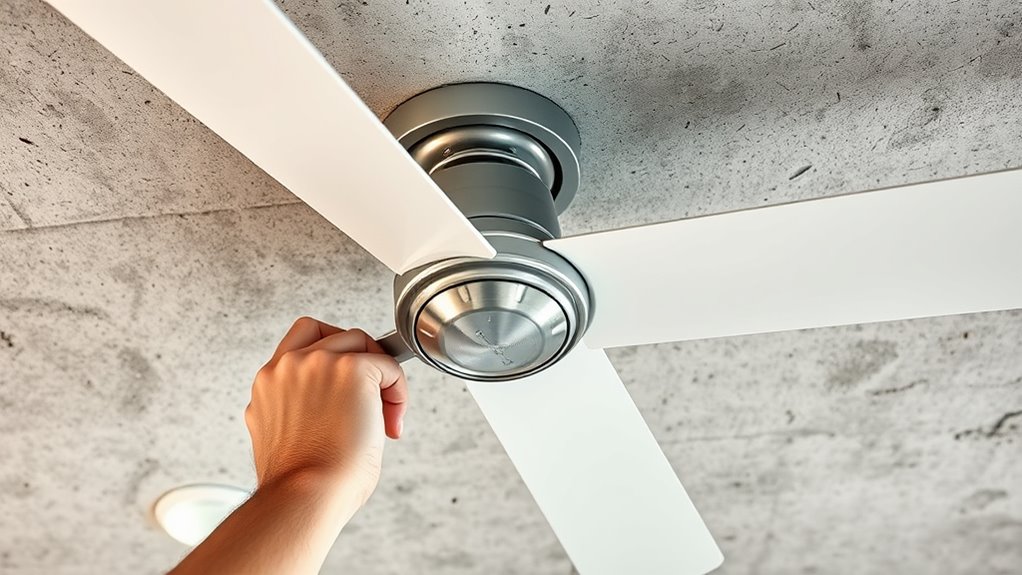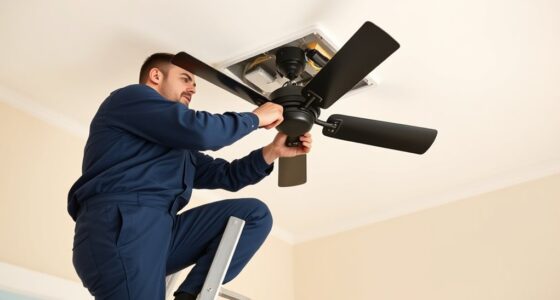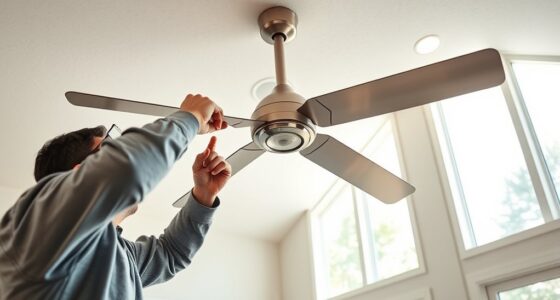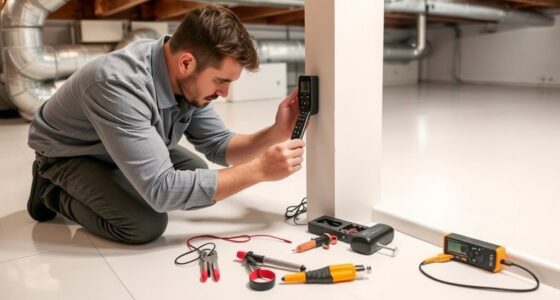When installing a fan on a concrete ceiling, you need to choose the right anchors to guarantee stability and safety. Use sleeve or drop-in anchors for solid support, especially for heavy fixtures. Molley bolts or chemical anchors work well if the concrete isn’t entirely solid. Proper placement, reinforcement checks, and level mounting are essential for long-term durability. Keep following along to discover detailed steps and tips to make your installation secure and reliable.
Key Takeaways
- Choose anchors rated for the fan’s weight, such as sleeve anchors or drop-in anchors, for secure support on concrete ceilings.
- Use corrosion-resistant anchors, especially in humid or outdoor environments, to ensure long-term durability.
- Properly drill holes to the recommended depth and diameter, following manufacturer instructions for optimal anchoring strength.
- Reinforce the ceiling around anchor points if necessary, to improve stability and safety of the fan installation.
- Ensure the mounting bracket is level and securely fastened to prevent movement and mechanical stress over time.
Understanding the Importance of Proper Anchors

Since a fan adds weight and vibration to your ceiling, using proper anchors is essential to guarantee it stays securely in place. The mounting surface of your concrete ceiling can vary in strength and texture, making the right anchor installation crucial. If you don’t choose the appropriate anchors, the fan might loosen or fall, risking damage or injury. Proper anchors distribute the load evenly and ensure the fan remains stable over time. You need to consider the thickness and condition of your concrete when selecting anchors. Secure anchor installation prevents movement caused by vibrations and keeps your fan functioning safely. Additionally, understanding projector technology can help you select the best mounting techniques for different types of fixtures. Investing time in understanding how to anchor correctly helps avoid future problems and ensures a reliable, long-lasting fixture on your concrete ceiling. Using the right anchor types can significantly improve the stability and safety of your installation. Properly selecting concrete anchors tailored to your specific wall or ceiling conditions will further enhance the durability of your installation.
Types of Anchors Suitable for Concrete Ceilings
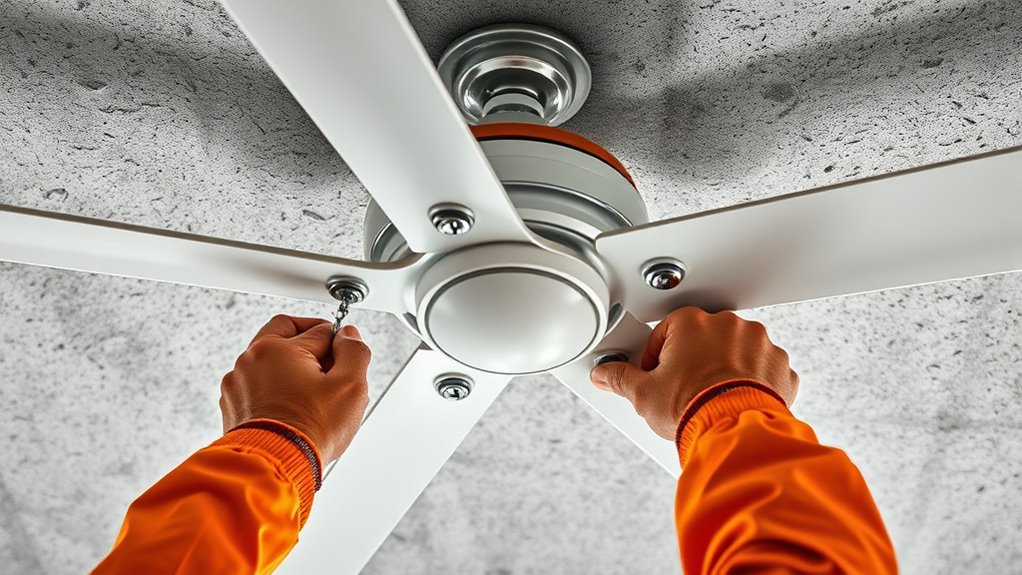
Choosing the right type of anchor for your concrete ceiling guarantees your fan stays secure and stable over time. For this, you need anchors with high anchor strength that can handle the weight and vibrations of the fan. Sleeve anchors and drop-in anchors are common options because they provide strong hold with proper installation techniques. Sleeve anchors expand within the drilled hole, offering reliable support, while drop-in anchors set flush with the surface, ideal for clean finishes. When selecting anchors, consider the load capacity and ensure your installation method follows manufacturer instructions. Proper installation techniques, like drilling the correct hole size and using the right tools, assure maximum holding power. Additionally, selecting versatile and reliable anchors suited for various conditions can further enhance safety and durability. For instance, using anchors designed specifically for concrete applications can improve overall security. Choosing anchors with corrosion resistance can also be beneficial in humid or outdoor environments. This way, your fan remains safely mounted, reducing the risk of accidents or damage.
Using Expansion Anchors for Heavy Fixtures
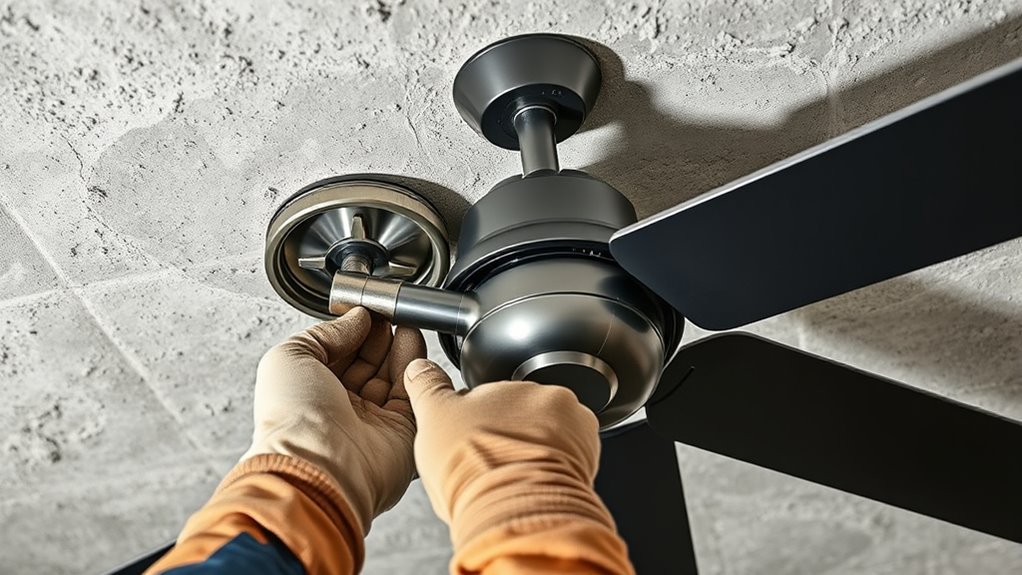
When installing heavy fixtures on a concrete ceiling, expansion anchors are an excellent choice because they provide strong, reliable support. The ceiling height can influence your selection, as taller ceilings may require anchors that maximize holding power to support the fan weight securely. Expansion anchors work by expanding within the drilled hole as you tighten the bolt, creating a tight fit that resists pull-out forces. For heavier fans, ensure you choose anchors rated for the specific weight, and follow the manufacturer’s guidelines for installation depth and diameter. Proper placement into solid concrete is essential to prevent future issues. Using these anchors correctly guarantees your fan stays securely mounted, even in high-ceiling environments.
The Role of Sleeve and Molly Bolts in Ceiling Mounting
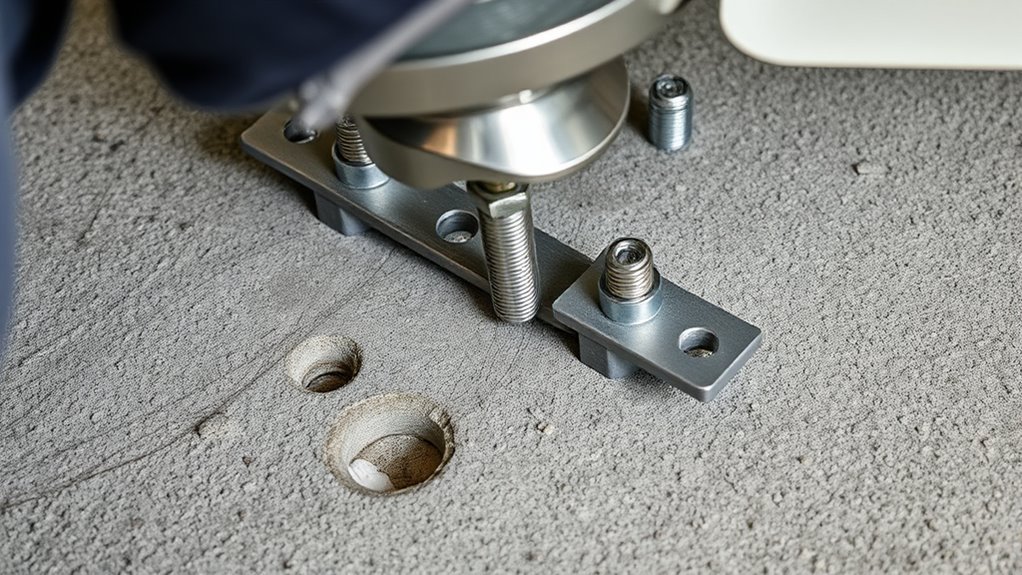
Sleeve and Molly bolts play a crucial role in ceiling mounting, especially when working with hollow or less-solid concrete surfaces. They provide secure anchors where traditional options might fail, ensuring your fixture stays firmly in place. These anchor types expand behind the surface, offering strong support for ceiling mounting applications. Here’s a quick comparison:
| Anchor Type | Best For | Installation Ease | Holding Strength |
|---|---|---|---|
| Sleeve Bolt | Hollow or weak concrete | Moderate | High |
| Molly Bolt | Drywall or thin concrete | Easy | Moderate |
| Expansion Anchor | Solid concrete | Easy | Very High |
| Sleeve Bolt | Hollow or less-solid surfaces | Moderate | High |
Choosing between these anchor types ensures your fan remains securely mounted, even in challenging ceiling conditions. Proper installation techniques are essential for maximizing the effectiveness of these anchors, especially since understanding the material properties of your ceiling can influence the best choice of anchor. Additionally, selecting the right anchor type based on the ceiling material can prevent damage and ensure safety.
Considering Chemical and Adhesive Anchors

Chemical and adhesive anchors are excellent options when traditional mechanical fasteners can’t provide the necessary support, especially in challenging concrete conditions. They’re ideal for situations where you need reliable holding power without compromising the structure’s integrity. These anchors also open up more ventilation options, allowing you to position your fan for optimal airflow while minimizing visible hardware. Plus, they offer aesthetic advantages by reducing clutter and unsightly fasteners, creating a cleaner, more streamlined look. When choosing chemical or adhesive anchors, ensure compatibility with your concrete type and consider the environment’s moisture levels. Proper installation is vital to maximize support and durability. Overall, these anchors provide a discreet, strong solution that balances function, airflow, and visual appeal in your ceiling fan setup.
Step-by-Step Guide to Installing Anchors for Your Fan
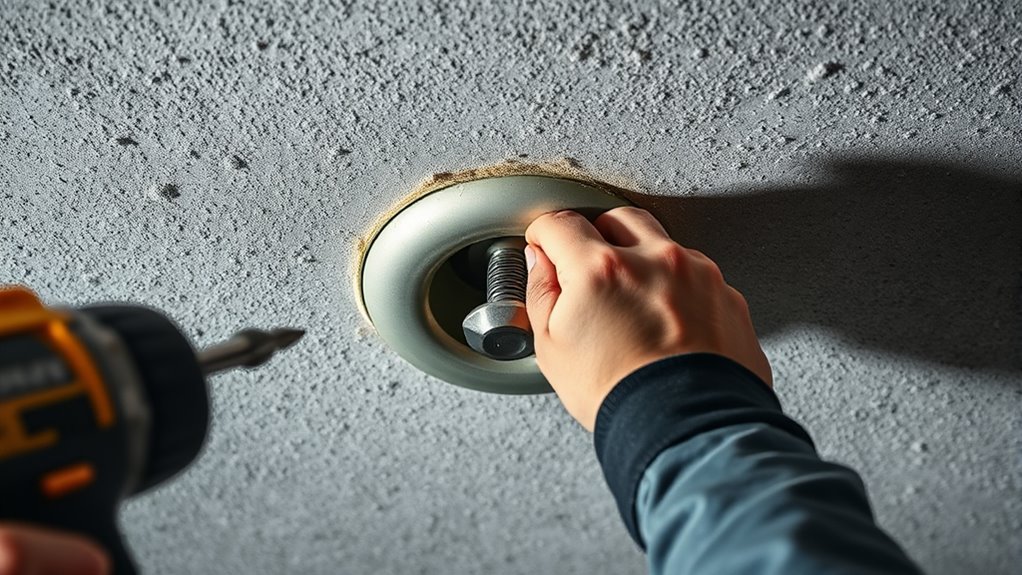
Installing the anchors correctly is key to ensuring your fan is secure and functions properly. Begin by marking the exact locations for the anchors, considering the electrical wiring route and ceiling aesthetics. Use a drill with a masonry bit to create holes at your marks, ensuring they’re deep enough for the anchors. Insert the anchors firmly into the holes, tapping them in if necessary. Next, align the mounting bracket of your fan with the anchors and insert the provided screws, tightening them securely. This process guarantees stability and supports the weight of your fan. Proper anchor placement also helps avoid damage to electrical wiring and maintains a clean ceiling appearance. Additionally, choosing the right type of anchor for concrete ceilings is crucial for a durable installation. Selecting the appropriate anchor type ensures maximum holding power and safety. Understanding anchor load capacity is essential to prevent potential failures. Follow these steps carefully for a safe, professional-looking installation that blends seamlessly with your ceiling.
Tips for Ensuring Maximum Safety and Stability

To guarantee maximum safety and stability when installing your ceiling fan, always double-check that the anchors are securely embedded and properly aligned before mounting the fan. Ensure the electrical wiring is correctly connected, following safety protocols to prevent shorts or electrical hazards. Inspect the ceiling reinforcement around the anchor points; if your ceiling isn’t reinforced, consider adding additional support to handle the fan’s weight. Use a level to verify the fan’s mounting bracket is straight, reducing strain on the anchors. Tighten all screws and connections firmly, avoiding over-tightening that could crack the concrete. Regularly examine the installation over time, especially after severe weather or vibrations, to maintain stability and safety. Proper attention to anchoring, wiring, and reinforcement guarantees a secure, long-lasting ceiling fan setup.
Frequently Asked Questions
How Do I Choose the Right Anchor Size for My Fan?
When choosing the right anchor size, you need to consider the anchor selection based on your fan’s weight capacity. Start by checking the fan’s weight and pick an anchor that can support at least twice that amount for safety. Larger anchors generally offer higher weight capacity, but make certain the size matches your concrete thickness. Properly installing the correct size ensures your fan stays secure and stable.
Can I Install a Fan on a Painted Concrete Ceiling?
Think of your painted concrete ceiling like a delicate canvas. Yes, you can install a fan, but you’ll need to handle it carefully. Check the decorative ceiling finishes to avoid damage, and make sure you consider electrical wiring considerations before drilling. Use appropriate anchors designed for concrete, and pre-drill to prevent cracking. With patience and proper tools, your fan will hang securely without ruining your painted masterpiece.
Are There Specific Tools Needed for Installing Concrete Anchors?
When installing concrete anchors, you’ll need a power drill and a concrete bit to make precise holes. These tools are essential because they allow you to drill into the hard surface safely and accurately. Make sure your power drill has enough torque, and use a suitable concrete bit size for your anchors. Proper tools guarantee a secure installation and prevent damage to the concrete or the anchors.
How Do I Prevent Cracking or Damaging the Concrete During Installation?
To prevent cracking and protect your concrete during installation, you should drill carefully using the right size drill bit and avoid excessive force. Use a low-speed drill and apply steady pressure to reduce stress on the concrete. Incorporate crack prevention techniques like avoiding over-tightening anchors and installing them at proper intervals. This approach guarantees concrete protection, minimizes damage, and maintains structural integrity during and after installation.
What Maintenance Is Required for Anchors After Installation?
Imagine a time before modern tools—regular anchor inspection keeps your installation safe. You should check anchors periodically for signs of wear, corrosion, or looseness. Clean and tighten them as needed, and apply corrosion prevention measures, like rust-resistant coatings, to prolong their lifespan. This simple maintenance guarantees your fan stays secure, preventing potential hazards. Staying vigilant with anchor care keeps your project safe, just like a trusted vintage radio keeps your favorite tunes alive.
Conclusion
Choosing the right anchor guarantees your fan stays secure, your ceiling remains safe, and your project stays successful. By understanding the types, using the proper method, and following safety tips, you protect your home, your investment, and your peace of mind. Confidence builds with each step, precision guides your progress, and safety keeps you secure. With the right anchors and careful installation, you create a space that’s stable, durable, and worry-free.
